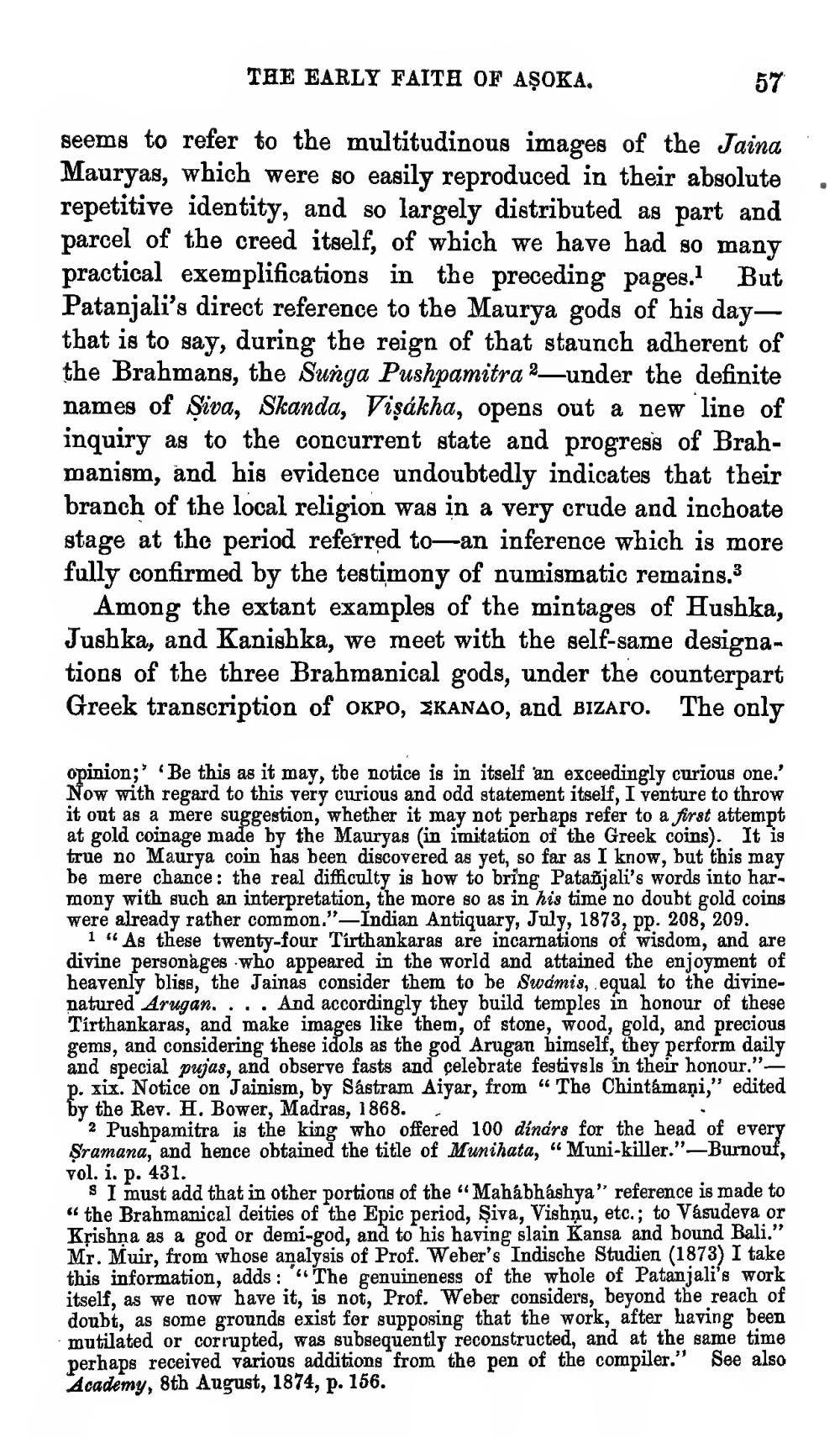________________
THE EARLY FAITH OF AṢOKA.
seems to refer to the multitudinous images of the Jaina Mauryas, which were so easily reproduced in their absolute repetitive identity, and so largely distributed as part and parcel of the creed itself, of which we have had so many practical exemplifications in the preceding pages. But Patanjali's direct reference to the Maurya gods of his daythat is to say, during the reign of that staunch adherent of the Brahmans, the Sunga Pushpamitra 2―under the definite names of Siva, Skanda, Viṣákha, opens out a new line of inquiry as to the concurrent state and progress of Brahmanism, and his evidence undoubtedly indicates that their branch of the local religion was in a very crude and inchoate stage at the period referred to an inference which is more fully confirmed by the testimony of numismatic remains.3
57
Among the extant examples of the mintages of Hushka, Jushka, and Kanishka, we meet with the self-same designations of the three Brahmanical gods, under the counterpart Greek transcription of OKPO, Kanao, and bizaro. The only
opinion; Be this as it may, the notice is in itself an exceedingly curious one.' Now with regard to this very curious and odd statement itself, I venture to throw it out as a mere suggestion, whether it may not perhaps refer to a first attempt at gold coinage made by the Mauryas (in imitation of the Greek coins). It is true no Maurya coin has been discovered as yet, so far as I know, but this may be mere chance: the real difficulty is how to bring Patanjali's words into harmony with such an interpretation, the more so as in his time no doubt gold coins were already rather common."-Indian Antiquary, July, 1873, pp. 208, 209.
1 "As these twenty-four Tirthankaras are incarnations of wisdom, and are divine personages who appeared in the world and attained the enjoyment of heavenly bliss, the Jainas consider them to be Swamis, equal to the divinenatured Arugan. And accordingly they build temples in honour of these Tirthankaras, and make images like them, of stone, wood, gold, and precious gems, and considering these idols as the god Arugan himself, they perform daily and special pujas, and observe fasts and celebrate festivsls in their honour."
p.
xix. Notice on Jainism, by Sástram Aiyar, from "The Chintamani," edited by the Rev. H. Bower, Madras, 1868.
2 Pushpamitra is the king who offered 100 dinars for the head of every Sramana, and hence obtained the title of Munihata, "Muni-killer."-Burnout, vol. i. p. 431.
s I must add that in other portions of the "Mahábháshya" reference is made to "the Brahmanical deities of the Epic period, Siva, Vishnu, etc.; to Vasudeva or Krishna as a god or demi-god, and to his having slain Kansa and bound Bali." Mr. Muir, from whose analysis of Prof. Weber's Indische Studien (1873) I take this information, adds: "The genuineness of the whole of Patanjali's work itself, as we now have it, is not, Prof. Weber considers, beyond the reach of doubt, as some grounds exist for supposing that the work, after having been mutilated or corrupted, was subsequently reconstructed, and at the same time perhaps received various additions from the pen of the compiler." See also Academy, 8th August, 1874, p. 156.
·




